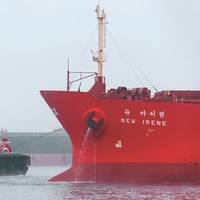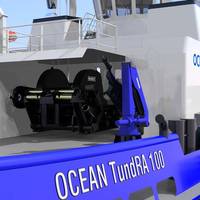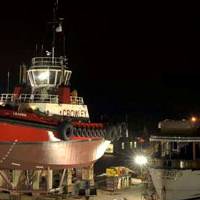Tech & Design Solutions for Modern Workboats

EPA Tier 4 regulations (for engines of 804 hp and higher) and propulsion advancements have many manufacturers and vessel designers changing course to adapt to new requirements and customer demands. Jensen Maritime is designing a new 110-ft. harbor class ship assist docking tug with 6,770 horsepower. “It’s a little larger than most. The extra length allows for towing which is secondary use,” says Vice President Johan Sperling. “There will be Tier 4 equipment in it. Bryan Nichols…
Markey Deck Machinery on Canadian Ice Class Tugs

Markey Equipment Selected For New Canadian Super Ice Class Tugs. Markey Machinery is pleased to announce that it has been awarded the order for a complete suite of deck machinery for the most powerful Harbor Class Tugs ever to be built in Canada. The tugs will be operated by Group Ocean of Quebec, Canada for harbor operations, ship escort services, short and long distance towing, as well as rescue operations and wreck removals. The new TunDRA 100 tugs, highly powerful, efficient and versatile…
Crowley, BSY Complete Repower the Leader

The air is a little cleaner at the Port of Los Angeles these days. Just this month, the new and improved Crowley harbor class tug Leader re-entered the ship assist and escort fleet of vessels following an extensive repowering of the vessel's main engines and generators. The repower project, the first of four Crowley tug engine replacements, will help reduce emissions and lessen overall environmental impact and is part of a larger Port of Los Angeles emissions and air quality initiative requiring vessel operators to upgrade their engines to be Tier II emissions compliant by 2013.
The Efficient Tugboat: The Efficient Tug
In many ports across the country, competition among tugboat operators is intense. The combined Port of Los Angeles and Long Beach is one such competitive environment for tug operators. Three companies vie for business that includes about 6,000 ship arrivals a year. Many of the companies utilize new tractor tugs to guide these ship movements. Foss Maritime, Crowley Marine and Millennium Maritime operate over a dozen modern tugs. Any slight edge in efficiency gives one company a competitive edge. For example, Foss Maritime recently placed the Halter Marine-built Marshall Foss into service. The 6,200 hp tug measures 98 x 40 x 16 ft. "This vessel was purpose built as a harbor tug," said Barry Baldwin, business director for Foss Maritime. Baldwin is located in Long Beach.
Crowley Christens Fifth Tractor Tug
Crowley Marine Services christened the fifth of its new Harbor-Class tractor tugs in Long Beach, Calif. Stephanie Goldberg, wife of Arco Marine executive Victor Goldberg, performed the tradition of christening Scout. The vessel was designed by Guido Perla and Associates, and constructed by Nichols Brothers Boat Builders in Freeland, Wash., for Vessel Management Services, Inc. Each tug features Voith Schneider twin cycloidal propulsion and a hydrofoil-shaped skeg that provides greatly improved steering, control and seakeeping ability. In addition, the unique hydrodynamics of the hull result in increased tons of indirect steering and braking forces, which are available to assist or control a vessel at higher speeds.
CMS Fleet Strongest in Region
Crowley Marine Services' Southern California fleet recently confirmed its strength by demonstrating ABS certified bollard pull test measurements of more than 100,000 lbs. for every tug in the region. The CMS is fleet is the highest hp and highest bollard pull fleet of tugs in the Los Angeles and Long Beach harbors. Tugs serving the Los Angeles and Long Beach market range from 4,400-7,000 hp and include several of Crowley's newest Harbor Class cycloidal tractor tugs and on Z-drive tug, as well as high-hp conventional vessels. Crowley also recently refurbished its Sea Robin Class to ABS' Guide to Rebuilding Vessels Less Than 90 Meters in Length standards. Two Sea Robin Class vessels are based at the Long Beach location.
Crowley Receives Last Of Tractor Tug Series
Crowley Marine Services has accepted the final vessel in a series of six new Harbor-Class tractor tugs from the company's subsidiary, Vessel Management Services, Inc. (VMS). The vessel, known as Chief, will be deployed in Puget Sound for ship assist and escort work. Designed by Seattle-based Guido Perla and Associates and constructed by Nichols Brother Boat Builders, for VMS, each of the six Harbor Class tugs features Voith Schneider twin cycloidal propulsion. Chief is powered by two Caterpillar 3516B engines and has a direct bollard pull of 111,500 lbs., with a free running speed of 14 knots.
Crowley Christens Fourth of Six Harbor-Class Tractor Tugs
Crowley Marine Services christened the fourth of its new Harbor-Class tractor tugs in January. Faye Plummer performed the time-honored tradition of christening Leader. Leader is the fourth of six 105-ft. Harbor-Class tractor tugs designed and constructed for Vessel Management Services, Inc. (VMS), a Crowley Maritime Corporation subsidiary. VMS has entered into a long-term bareboat charter of Leader to Crowley Marine Services. Each of the six ship assist and escort tugs feature Voith Schneider twin cycloidal propulsion and a hydrofoil-shaped skeg that provides greatly improved steering, control and seakeeping ability when the vessel is running at high speeds in the skeg-first direction.










